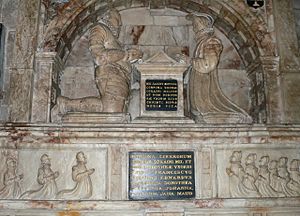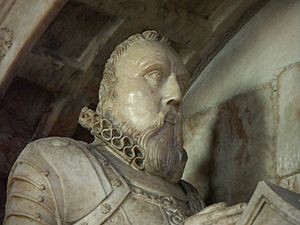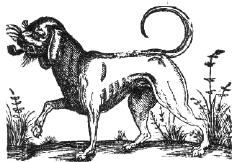Thomas Cokayne facts for kids
Sir Thomas Cokayne (born November 27, 1520 – died November 15, 1592) was an important English figure. He was a brave soldier, a skilled huntsman, and a Member of Parliament (MP) for Derbyshire in 1553.
Contents
Who Was Thomas Cokayne?
Thomas Cokayne was born in Ashbourne, Derbyshire, on November 27, 1520. His parents were Francis Cokayne and Dorothy Marrow. The Cokayne family was very old and well-known in Derbyshire. They had lived in Ashbourne since the 1100s and owned many lands.
When Thomas was 18, in 1538, his father passed away. This meant Thomas became the head of the family. The next year, he joined Gray's Inn, which was a place where people studied law. He also started working for Francis Talbot, 5th Earl of Shrewsbury, a powerful nobleman.
What Was His Military Career Like?
Thomas Cokayne loved being a soldier, just like his grandfather. People at the time said he was a "bold and worthy knight."
Fighting in Scotland
In 1544, Thomas took part in a conflict with Scotland called the Rough Wooing. He fought alongside Edward Seymour, 1st Duke of Somerset. He was knighted on May 11, 1544, for his bravery during the Burning of Edinburgh. This was a big honor for a soldier.
Later, in 1548, he was listed as one of the captains chosen to help George Talbot, 6th Earl of Shrewsbury during the Siege of Haddington. Thomas was very thankful to the Earls of Shrewsbury for their support in his military life.
Facing the Spanish Armada
Years later, during the reign of Queen Elizabeth I, Thomas Cokayne was part of the English forces that faced the Spanish Armada. This was a huge fleet of Spanish ships trying to invade England. He fought in the famous Battle of Gravelines in 1588.
In 1587, he was chosen to escort Mary, Queen of Scots, on part of her journey to her final prison. This showed that Queen Elizabeth trusted him a lot. He was seen as a loyal subject who believed in the right religion.
What Public Jobs Did He Hold?
Thomas Cokayne was a very important person in his local area. He helped the government and the church.
Important Roles in Derbyshire
His first public job was in 1546, checking the soldiers in Derbyshire. He did this job again in 1577 and 1584. He also served as a Justice of the peace (JP) for Derbyshire in 1547 and 1555. A JP helps keep law and order.
He was also the sheriff for Nottinghamshire and Derbyshire several times. The sheriff was a key local official. He held other jobs too, like collecting taxes and looking after Ravensdale Park.
Serving in Parliament
In March 1553, Thomas Cokayne became a Member of Parliament for Derbyshire. He likely got this job because the Earl of Shrewsbury supported him. His experience as a soldier and sheriff also helped. It's said he might have preferred being on a horse rather than sitting in Parliament!
Other Duties
Thomas also took on other important tasks. In 1564, he advised a Scottish Protestant leader about the religious beliefs of other JPs. He helped investigate a disagreement between the Earl of Shrewsbury and his tenants. He even questioned someone who was writing to Mary, Queen of Scots. In 1586, he took control of the belongings of Anthony Babington, who tried to assassinate Queen Elizabeth.
In 1588, he showed his loyalty to the Queen by donating £50 to help fund the fight against the Spanish Armada.
A Short Treatise of Hunting (1591)
Thomas Cokayne loved hunting. He said he was "a professed hunter, and not a scholler" (meaning he was a hunter, not a scholar). When he was older, he wrote a book called A Short Treatise of Hunting in 1591. It was full of hunting tips for noblemen and gentlemen.
Why Hunting Was Important
Thomas had 52 years of hunting experience. He believed hunting was a great activity. He wrote that hunters become strong and brave. They learn to endure hunger, heat, and cold. This made them better soldiers for their country. He also said hunting helped protect England from harmful animals like foxes.
He defended hunting from people who criticized it. However, he also warned against spending too much time hunting. He said it should not stop people from serving God, the Queen, or their country. He dedicated his book to Gilbert Talbot, 7th Earl of Shrewsbury. The book also had pictures of different animals.
His Family and Final Years
Around 1540, Thomas Cokayne married Dorothy Ferrers. They had seven daughters and three sons. A writer named Raphael Holinshed often visited Thomas.
Thomas wrote his will on December 8, 1591. He asked that his funeral be simple, without "vain pomp or foolish ceremonies." He passed away on November 15, 1592, and was buried that night. Dorothy died three years later.
His Monument

After they died, a large monument was built for Thomas and Dorothy in St Oswald's Church, Ashbourne. Many of his ancestors had similar monuments there. This monument is made of alabaster and marble in a Renaissance style.
It shows full-sized figures of Thomas and Dorothy kneeling and facing each other over a prayer desk. Below them are smaller figures of their children: three sons under Thomas and seven daughters under Dorothy.



